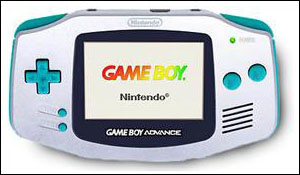
 |

|
|
|
G a m e B o y A d v a n c e
Presentation
 Nintendo GameBoy Advance™ Technical Specifications
History
Nintendo unveiled the GameBoy Advance on August 24th 2000 at Spaceworld in Tokyo, Japan
after talks of the console going back to a year before. It was released to the public on March 21th 2001 for a price
of 9800 yen. Nintendo felt it was time to upgrade the capabilities of their GameBoy after over a decade on the market
and many changes in appearance, size and a color screen.
The GameBoy Advance is what Nintendo wanted to achieve with Project Atlantis (a 32-bit color handheld that was backwards compatible). It is almost the exact same size as the GameBoy Color, but held lengthwise with the buttons at the sides and the screen in the middle. It features all the same buttons as the other GameBoys except for two extras on top (shoulder buttons). The screen is wider and larger than normal GameBoy screen, GameBoy Advance is fully backwards compatible with GameBoy and GameBoy Color games which means you have access to a huge library of titles. GameBoy Advance take cartridges which are about half the size of normal GameBoy carts. The GameBoy Advance can be attached to the GameCube, and games will interface between the two consoles. Develop for GameBoy Advance
Like every game consoles development, it's necessary to get a license from the
constructor. It will provide you the official development kit and all the technical documentations. You can get this
license, if your project is approved by Nintendo, at this address :
However, there are other opportunities to develop for GBA. But you have to know that these procedures are not certified by Nintendo. You won't be able to get all the advantages that official developers have, nor publish your own productions. But it's still a good way to learn how to program this console. You will find all you need at these addresses :
In an other tutorial we will see how to install and set up the development kit DevKit-Advance, and we will see step by step the creation of a small game on GBA. |
 |
 |
| © 2000-2025 Exood4 Studio. All rights reserved. |